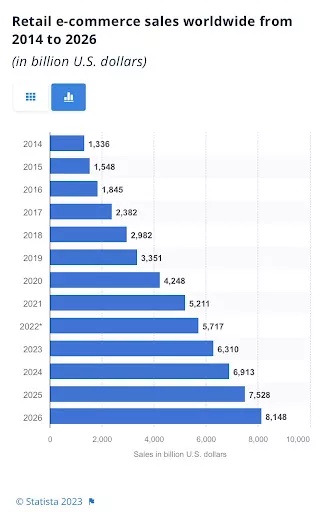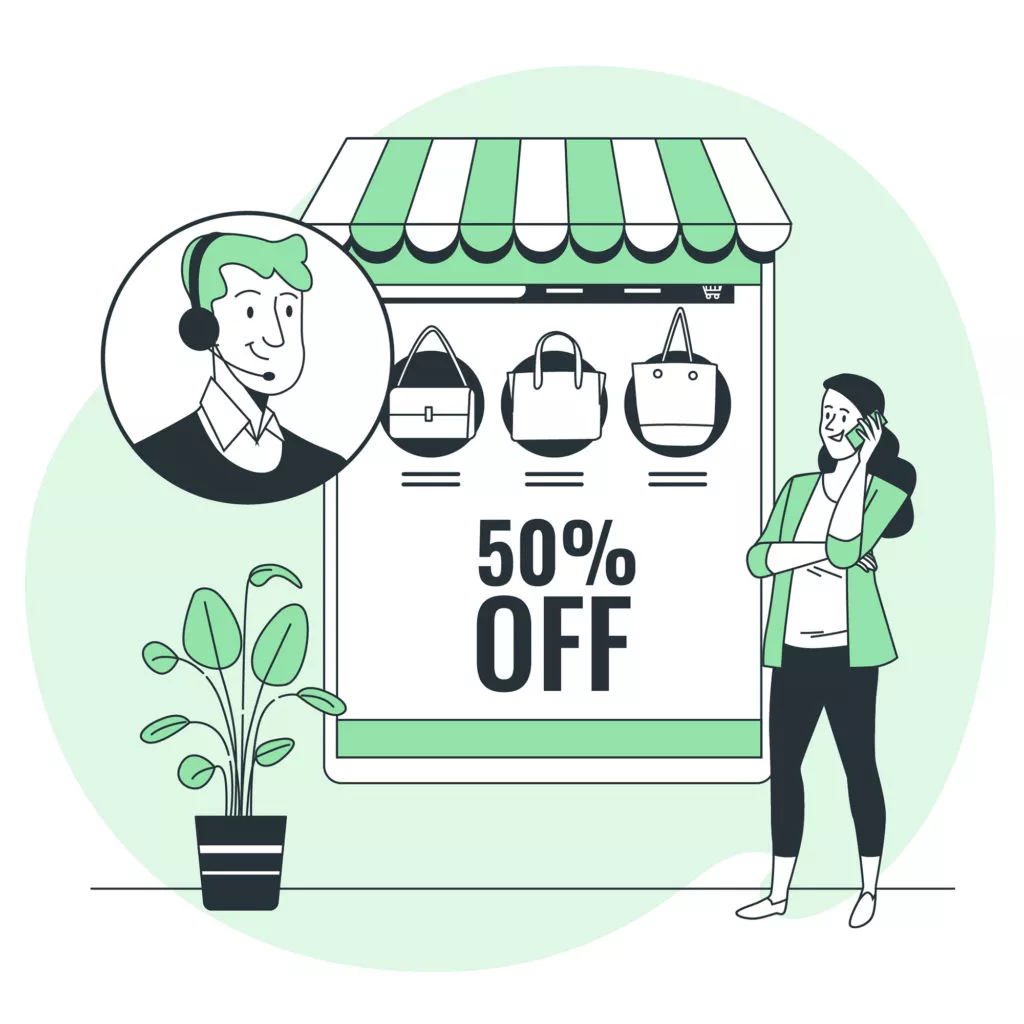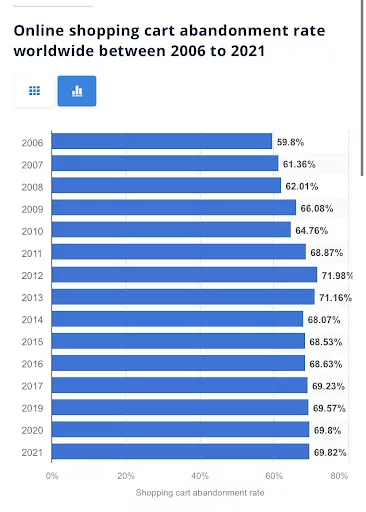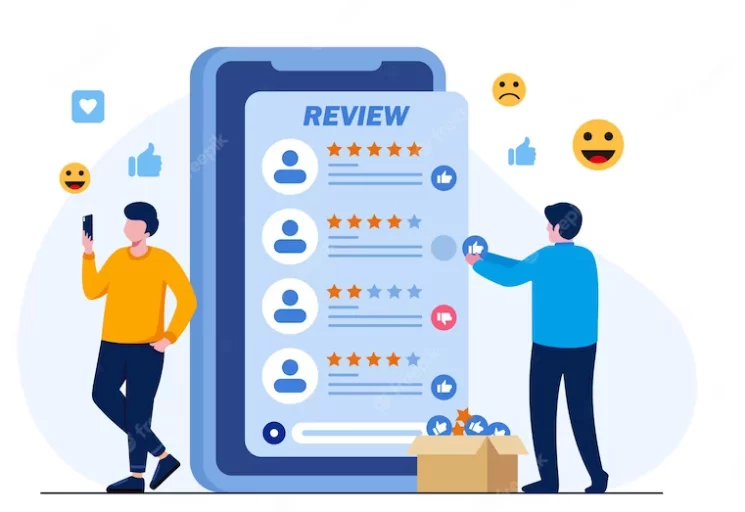You’ve just launched a fantastic online store. You’ve chosen hot products, designed a fantastic website, and are waiting for the orders to pour in. Your results, however, have been nothing like impressive this far.
The first stage in starting a successful online business is setting up an ecommerce store; the next is developing long-term plans that help boost e-commerce sales of your store.
You don’t have to exhaust yourself doing it, we assure you. Most of the time, a mix of simple strategies operating in consensus will enable you to meet your e-commerce sales targets.

What Exactly Is E-Commerce Sales?
Marketing in the digital realm is spreading the word about your wares to current and future customers. The success of your online shop will largely determine the direction you choose with your e-commerce marketing plan. You can be trying to increase sales of a specific item, boost brand recognition, or increase website visits. It is impossible to select an effective eCommerce marketing plan without first establishing a clear goal.
Promotional activities on social media, websites, search engines, and email marketing campaigns are all part of a well-developed e-commerce sales strategy.
Tips to Boost E-commerce Sales
-
Create an email list
The first one is pretty significant! You cross off a number of important business-building chores when you create a tribe of devoted clients. There are many ways to establish an email list for your ecommerce company without having to reinvent the wheel, despite the fact that at first it could seem like a daunting process.
Because your customers opt-in to hear more from you rather than being targeted by paid advertisements, email marketing is so effective. Also, whereas you do not own social media sites, you have complete control with your email list.
- Those who are already interested in your items are being retargeted by you.
- Without having to pay for social media advertisements, you are granted authority to send promos.
- You are opening the door for community development.
A. Pop Ups
Popups are one of the best email list building techniques for online stores, if that answers your question. You can set them to be activated when a visitor spends a specific amount of time on your page or when they scroll to a specific point on the page to make sure they aren’t too invasive. And you definitely don’t want to turn away consumers looking at all the amazing products in your store!
B. Checkbox
Including an opt-in checkbox during the checkout process is another successful strategy for growing an email list. A popup would be far more obtrusive than this. Also, the customer who is checking out is almost ready to make a purchase from you. The checkbox to ask for permission to add them to your list should be added as they are already giving their email address to place an order. A 10% discount added as an opt-in incentive will give them the final push needed to finish the purchase, giving you a new member.
C. CTA buttons
CTA buttons seem like a little element, but when used effectively, they can be incredibly effective! Just changing “Sign Up” to “Get Started” makes the message considerably more effective and action-oriented. Rather than using a placeholder phrase like “Sign Up,” make sure you optimize your call-to-action button when creating your opt-in forms.
-
Establish a successful email marketing strategy
Making your email list a crucial component of your marketing strategy is the logical next step after creating one. The monotonous weekly newsletter sent to every subscriber isn’t the ideal method to make the most of your mail list because not everyone in the audience would find the content as pertinent. Instead, divide your audience into groups based on things they have bought from you.
You can send newsletters and promotions that are more appropriate for each category to your subscriber list’s segments. Personalization increases the likelihood that your audience will interact with your brand and stay subscribed. You can for instance, include checkbox alternatives while asking users to confirm their membership to learn:
- The product category in which they are most interested
- Which promotions they’d be interested in learning about
- How they discovered your store
-
Use scarcity strategies
Scarcity gives the ultimate adrenaline rush. Scarcity can raise click-through rates and purchases, and it’s really simple to apply in your marketing approach. To take advantage of the offer, just add a popup with a succinct message and/or a promo code to certain pages. Your visitors are more inclined to purchase products right away if your goods appear to be in short supply or if a sale is only happening for a limited period. They are unable to guarantee that your products will still be offered at this price—or even available—in the future. You can increase your e-commerce sales by using scarcity in the following ways:
- Launch flash sales
- Add a countdown clock to your website during sales
- Write “only x left” for your products
- Offer free shipping
-
Increase customer upsells
You may do a joyful dance to commemorate the fact that one of your visitors has added something to their cart. Furthermore, boost your chances of making a transaction, you may try to upsell your visitors. Inserting popups to promote a better, more expensive item is one of the simplest ways to include upsells.

Using the “You May Also Like” upselling technique: If you don’t use this strategy, you might be losing out on money since upsells and renewals account for an average of 70–95 percent of the income generated by online stores that provide them.
Also, selling to existing clients is 5 times simpler than trying to draw in new ones. Upsells are a simple way to maximize the value of your current clients.
-
Make your store mobile-friendly
Consumers enjoy buying on their phones, and this practice is becoming more popular. In 2022, mobile devices accounted for 40.1% of US e-commerce sales, up from just 36.9% in 2019.
So, e-commerce businesses now place a high importance on having a well-designed website that is optimized for conversions and is also mobile-friendly.
Mobile e-commerce business owners are getting ready and Statista reports that the conversion rate for mobile customers is rising and recently hit 3.5%, which is very close to the 3.9% for customers using desktop computers. Because of the intense competition, businesses that don’t offer a seamless mobile experience lose out on business.
-
Employ SEO plug-ins
Consider it this way: each time a visitor arrives at your website via an organic search, you are saving money on paid advertising. If SEO makes you want to flee, we understand. SEO is a difficult task in and of itself. Your organic traffic will grow if you optimize the online store for search engines, especially if you rank on the top page of Google for a particular phrase. Who doesn’t enjoy free traffic, after all?
SEO for e-commerce sites doesn’t consume a lot of time, and you can choose from a number of excellent plugins to make the process easier. Although some are payable and some are free, these plugins are generally inexpensive and deliver fantastic return on investments when used efficiently.
-
Reduce cart abandonment to a minimum
Any online store owner will recognize the following: you receive a notification that someone has added items from your shop to their cart. You start feeling optimistic that things are finally going in the right direction as you get all giddy about the huge sale coming your way.
But then, without completing the transaction, the visitor abruptly leaves their cart! That occurs more frequently than you’d like, and you could feel helpless. But fear not—there are simple strategies to reduce cart abandonment. As per Statista, shopping cart abandonment rate is consistent from 2006 to 2021, all the more reason why you should pay more attention to this aspect.

Exit-intent popups, for example, can sway a visitor’s decision to click the “x” on the tab for your store. These popups are programmed to recognize when a customer is dragging their mouse away from your shop and offer them one final chance to take advantage of an alluring promotion if they finish their purchase.
-
Highlight your best-selling products
The top-selling items in your store should be featured on the landing page. This will be the first thing visitors see, giving you one chance to make a good impression and boost your e-commerce sales in an indirect way. Instead of overloading your customers with your available product options via your menus, you’ll establish an excellent first impression and provide a starting point for their shopping spree by showing your best-selling items on your front page. Additionally, there’s a good reason why these goods are best-sellers. Use their influence to draw all new customers to your shop.
-
Make use of Instagram Shoppable Posts
Have you heard of Instagram’s shoppable posts? You can link directly to your ecommerce store from your Instagram Business profile if your company is a member of one of Instagram’s supported marketplaces and abides by their restrictions on online sale. Thanks to its 1 billion monthly active users (and 500 million daily users, Instagram offers a wide-open window of business potential).
This is especially true if your store has visual solid branding. Your Instagram followers might be attracted to your products by using alluring photographs of them, which you can then utilize to link to a product page on your online shop.
Adding your feed directly to your e-commerce website is another option to incorporate Instagram. This will boost your participation on social media. And engaged visitors are likely to buy again from you in the future.

-
Display your reviews
Unbeknownst to you, 70% of consumers base their decisions on online reviews. You’re missing out on a sizable portion of prospective revenue without using reviews. Including ratings in your items is one simple approach to taking advantage of reviews. Make careful you remind customers to post reviews, as they could need to remember to do so on their own.
Reaching out to some of your most devoted clients, individuals who have made many purchases from your shop, and asking for a review is another strategy to strengthen your online reviews. Reviews are more focused on a single product, whereas testimonials can increase trust in your brand. This is how testimonials differ from reviews.
After you have these endorsements, put them front and center on your landing page to instantly project credibility to potential customers. As your visitors may recognize the client as genuine, testimonials perform much better when you utilize a real name and photo.
-
Introduce live chat
One of these e-commerce marketing tools is a live chat, which may seem complicated to use but is relatively easy. Whenever customers have a query, you or your customer service representatives can answer them immediately by adding a live chat option to your store. And if you’re making your prospective customers jump through hoops to contact you, they’re more likely to click away entirely.
Imagine this, for instance: Before deciding which size to purchase, your visitor wants to know if your outfit fits as expected. They must click on your contact page, copy your email address, launch their email client, and put their inquiry into an email to contact you. That’s a lot of steps, and they divert the customer from your store, which could lose you the sale. And it’s not just conjecture either; 77% of users say they will only purchase on a website if live chat is an option.
In contrast, if you have a live chat option set up right on your website, a visitor can stay on the page and communicate with a customer support representative.
-
Use A/B testing
How can you tell which conversion optimization strategies for your ecommerce store are most effective and which are utterly ineffective? You can’t, honestly. Testing your options is the only practical method to discover what works.
A/B testing is a valuable technique. It compares two different headlines, product descriptions, page layouts, and more to see which one performs better. Most A/B testing solutions include vital metrics in providing in-depth information on the effectiveness of your instances. After a better understanding of what works best for your store, iterate changes to your store’s experience and compare different possibilities. Since you’re using only data to optimize conversions, each new iteration will help you increase your online sales.
You can even improve your clients’ experiences by using A/B testing. Your clients are more likely to return and make more purchases from you if they have had a positive experience.
A/B testing can be complicated, and you must regularly improve your shop. With the correct tools, you can implement these tests without battling technology; all you need to do is create compelling content to test out.
-
Retarget your visitors on social media
First-time customers frequently peruse your store for a while before leaving empty-handed. Although that is a fact of running an online company, you can still take steps to retain bouncing customers.
Visitor retargeting can help with that. You can determine who has visited your website and whether they made a purchase using a Facebook pixel. From there, you can direct these individuals in your paid social media advertising.
Retargeting can be used in many different contexts. For instance, you might use social media for advertising a product to a customer who left your business after clicking on it and give them a limited-time or limited-quantity discount (scarcity!).
On the other hand, if someone added items to their cart and abandoned the page, you can point this out and give them a discount if they finish their order.
Here’s the deal: It’s possible that customers will only use your brand for their initial purchase, and the second time around, they might not buy either. Yet, customers are more likely to purchase from you, and in the long run, they receive more exposure to your store. And the first step to becoming a recurring customer is making that first transaction. It’s crucial to remember that keeping existing customers happy is much simpler than finding new ones.
-
Add a post-purchase survey to your website
A post-purchase survey can teach you a lot about your consumers’ experiences. You can ask what made them do business with you, what would have been a deal-breaker, or how you could have improved their experience.
By looking through the eyes of your clients, you may identify your strengths and faults. Their opinion is what you should value the most because it is them that you are attempting to impress.

Give survey respondents a coupon voucher for their subsequent purchase to encourage more responses. Give your consumers an incentive by mentioning the reward before the survey and including it on the form’s final page or in an email.
-
Provide multiple payment options
Your clients abandoning their purchase because their preferred payment method isn’t accessible is the last thing you want. This problem will be substantially avoided by offering a range of payment options, especially on mobile. According to the most recent statistics on online buying, mobile wallets like Apple Pay, Amazon Pay, Samsung Pay and Google Pay are evolving into the new norm. Ensure to provide the most popular payment options for e-commerce, and always pay attention to requests and complaints from your consumers regarding this. Faster and hassle-free payment options will automatically increase e-commerce sales.
-
Personalize your messages to your visitors
Messages that are personally tailored look more sincere. Remember to value the impact of a personalized message; it can work wonders to increase the likelihood that a potential consumer will purchase from you. They have the power to elevate, notice, and value others. You want your clients to feel precisely this way!
You may add personalization to your marketing initiatives in various ways, including emails, advertising, landing pages, and even website popups. For instance, you can use the dynamic text replacement capability to show a visitor’s name, current location, or date.
Conclusion
Rather than shouting into the abyss of cyberspace, these strategies help navigate for you. Soon enough, you’ll be able to set attainable objectives for your brand, bringing your vision of a $1 million e-commerce sales empire closer than ever. Work smart by implementing these strategies!
FAQs ON E-COMMERCE SALES
What are some of the most popular choices for online purchases?
Credit cards, debit cards, digital wallets, bank transfers, and PayPal are all common methods of payment for online purchases.
Can you recommend some tried and true methods for boosting online sales?
Enhancing the website’s design and user experience, running deals and promotions, promoting the site via social media, and providing outstanding customer service are all proven methods for boosting online sales.
How can companies protect their customers’ personal information during online purchases.?
Using encrypted data transmissions, secure payment gateways, and other best practices help protect customers during online purchases.
Can you name some difficulties encountered by online retailers?
Competition, shifting consumer tastes, logistical difficulties, security worries, and keeping up with new technologies are just some of the obstacles that online retailers must overcome.



